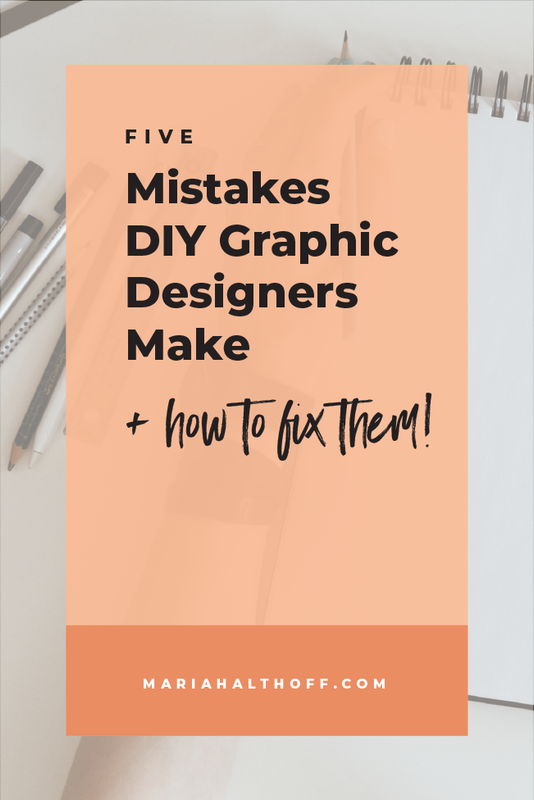5 Mistakes DIY Designers Make and How to Fix Them
If you’re a regular here at MariahAlthoff.com, you know it’s my goal is for each and every one of you to be killer designers. However, depending on your experience level and your design skillz, you may still be making a few mistakes that you don't even realize you're making.
The good news is, I’ve put together a list of the top 5 design mistakes I typically see DIY designers make – and they're SUPER easy to fix. Once you’re aware of these mistakes you’ll be one step closer to being that bad a$$ designer that I know is somewhere inside you.
Until then, here are the top 5 mistakes DIY graphic designers make and how to fix them:
1. Using too many fonts
Using several fonts within one graphic, web page, or overall brand gets confusing, difficult to read – and looks crappy.
Unless you are a typography pro – like I’m talking serious wizard or a superstar hand-lettering queen – just don’t do it.
For example, those super trendy quote graphics that are all over Pinterest and Etsy that use one million different fonts ? Those are actually super hard to successfully create, even for an experienced designer. So, even if you think using a bajillion fonts is the cool thing to do – don’t.
Solution: Stick to 2-3 fonts. ALWAYS.
Choosing just 2-3 fonts to use throughout your entire brand will not only increase your brand recognition by making it more cohesive, but it will also seriously improve the quality of your graphics. Our brains don’t want to process more than 2-3 fonts at a time, no matter how badly you want them to.
Having trouble choosing just two or three fonts to use? Let me help you over here at –> How to Choose the Best Font Pairing for your Brand.
2. Using an inconsistent color palette
Those of us who love ALL THE FONTS probably also love ALL THE COLORS. But, just because you love them all doesn’t mean you should use them all.
I often see brands who seem to haphazardly choose whatever color fits their mood that day, matches the color of their shirt, pairs nicely with their nail polish, or whatever they’re being called to choose in that particular minute. But – I’m here to tell you that this is wrong and that you shouldn't change your colors on the daily.
While I too have trouble choosing a favorite color, you can’t use every single one if you want a successful visual brand identity.
Solution: Choose 3-5 brand colors and stick with them for EVERYTHING
Your brand colors help set the tone for who you are and what you’re all about. By literally choosing the entire rainbow on any given day, you’re confusing your audience and not making an impactful first impression or creating the brand recognition you deserve. You want your audience to be able to remember and recognize your brand – and a major component of that is your brand colors.
For example, when you first visualize Target, you probably automatically think of the color red, right? And Walmart? – immediately you think of their blue and yellow.
You want your audience to recognize and remember your brand colors just as easily as they can with Target or Walmart's. The only way they can do that is if you only use 3-5 colors that you stick to CONSISTENTLY.
Need help with choosing your brand’s color palette? This post is for you! (It’s also my most popular post so you definitely want to check it out).
3. Over-designing
Have you ever had that feeling of, “I didn’t actually design enough” so you end up throwing some other crap in the corner to make you feel like you actually “designed” something?
Same. So it’s not just you, but this IS a problem. When you over design, you use up all of your white space and over-crowd your graphics. This makes them hard to read, difficult to understand and less attractive. The more crap you throw in there "just because", the less intentional it looks and the more amateur it feels.
Solution: Simplicity is key
As hard as it often can be, the key to design is always simplicity. The easier it feels, the better the design. Including an ample amount of intentional space in your graphics is the best way to ensure this simplicity.
Don’t believe me? Take Apple for instance. They are the KING of design and their logo is literally just an apple. That’s it. There’s nothing more to it. Their branding is SUPER clean and minimal – which is exactly what makes it so good.
So when you’re stuck in a design rut and don’t know what design elements you should add to your graphic, think of Apple and don’t put any crap on there at all!
If it doesn’t have a real purpose, leave it off.
4. Using inconsistent imagery
Choosing imagery is as important as choosing any other design element to accompany or represent your brand. Choosing which stock photo to pair with your new blog post may seem like a menial task, but choosing your imagery without purpose will lead to your brand feeling less cohesive and unrecognizable.
Solution: Choose imagery that fits your brand
Not only do your photos need to match the content they’re accompanying, but they also need to consistently match your visual branding. You can go about this in several different ways, such as:
Choosing photos that consistently incorporate the same color palette
Using photos that fit a certain mood, theme or style
Picking photos that you can add a color overlay overtop of to match your brand colors
Ensuring that your imagery looks consistent with your visual brand is just as important as any other brand element – so make sure you pay attention to it. Using the appropriate imagery can easily take you from amateur to pro, in the blink of an eye.
Need help choosing relevant imagery? Head to this post –> How to Effectively Use Stock Photos for your Blog or Business.
5. Scaling images disproportionately
THIS. This is my biggest pet peeve of all! I saved the best for last, you see.
Scaling images disproportionately is THE biggest giveaway that you’re a newbie designer. Stretching photos, words, images, and shapes disproportionately looks dumb.
Solution: Use the shift key
This is literally the easiest solution of them all – USE THE SHIFT KEY! Anytime you are resizing anything, please, for all that is holy, use the shift key! If whatever design element you’re using doesn’t fit in the designated space proportionately, don’t stretch it out to make it fit. Rearrange your design until everything fits how you intended.
Graphic design is a puzzle – which sometimes is a total headache, but try to think of it as a fun challenge. Don’t cheat the puzzle by disproportionately stretching images, because it’s not even cheating, its just ugly.















